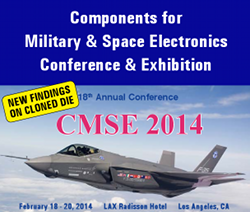
Space and defense electronics are two of the most conservative markets in terms of new materials qualification – unless there is a pressing technical issue. Counterfeiting is a huge issue for space, where recall and repair are excruciatingly expensive, or impractical [1][2]. One of the root causes for a recent failure was alleged to be counterfeit SRAM memory chips. In aviation and defense, the problems may be due to the age of the systems and the reliance and rapid obsolescence of COTS (“commercial-off-the shelf”) electronics with a lifetime of a few years whereas weapons systems have lifetimes of decades. An extreme example is the B-52, first flown in 1952 with a projected retirement date of 2040! Couple this with data quoted by King that 57% of counterfeit-part reports from 2001 through 2012 involved obsolete components and we have a real problem.
Counterfeit parts in circulation include used parts, presented as new; manufacturers’ reject parts; parts with a lower specification that are upgraded by “blacktopping” and relabeling and, most insidiously, cloned parts which may or may not function as well as the original part but which may have malicious “back doors” or “kill switches” which have obvious implications for military systems.
I had the privilege of chairing the February 20 CMSE (Components for Military and Space Electronics) session on Supply Chain – Counterfeit and Obsolete, where we covered topics ranging from design through clone identification through circuit camouflage through taggants and secure data destruction.
Thomas Sharpe of SMT Corporation gave a chilling account of the “arms race” in the clone detection business. Disclosure of a solvent detection system led to solvent-resistant blacktopping compounds within a few months. Now, new discoveries and ways to defeat them are not disseminated. Needless to say, several of his slides were not published and photography was specifically banned in the session.
Ron Cocchi of SypherMedia outlined an ingenious way to disguise nano-sized circuits as small as 40nm. Metal layers have non-functional features which, to image recognition software, look identical to features such as ASIC gates. These make reverse engineering virtually impossible when there are millions of gates, and fill up spaces that could be used to insert malicious Trojan circuits. Over 200 million parts have been produced.
Janice Meraglia of Applied DNA Sciences outlined progress in DNA marking since the DLA (Defense Logistics Agency) DLAD 52.11-9074 directive on DNA marking. Plant DNA is incorporated with phosphors in ink or epoxy that can be resistant to reflow. The phosphors give a field-level check and the DNA gives a non-destructive test with a 3-day turnaround. With millions of possible “codes”, the DNA itself is virtually impossible to duplicate and a verified and trusted marking infrastructure has been put in place. Last year there was a collective howl of protest from the electronics industry as this system was rolled out but now more and more suppliers are falling in line.
Bob Lowry from Arthur Jonath Associates outlined a clever near-nano approach using mixed ceramic phosphors and a detector system that could analyze parameters such as peak height, position, width and decay rate when the phosphors are illuminated with a laser, with a coded readout indicating authenticity. The phosphors can be incorporated in bulk materials as well as inks and coatings.
The best nano taggants require a robust and trusted supporting infrastructure that is the subject of discussion throughout the electronics, automotive and pharmaceutical industry. This holistic approach is being examined by organizations including SAE International, iNEMI (International Electronics Manufacturing Initiative) and HDPUG (High Density Packaging Users Group) in order to set up systems to cover consumer, automotive and medical products.
This is a classic illustration of the unique challenges and opportunities for nanotechnology. Here is an example of a unique and practical tool – a hard to duplicate taggant- which can meet overwhelming industry resistance to deployment and commercialization until there is an equally overwhelming need. For many of us throughout the nano business, finding the need and figuring out when it will occur are the big questions that keep us awake at night!
References:
[1] "Counterfeiting, The Risk To Satellites”, R.King SatMagazine.com, 2012
[2] “Counterfeit Electronics Parts”, T Wilcutt et. al, NASA Leadership ViTS Meeting, May 2012
